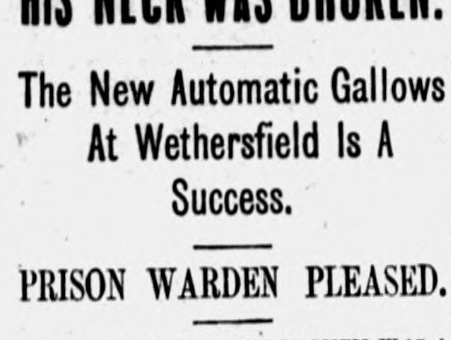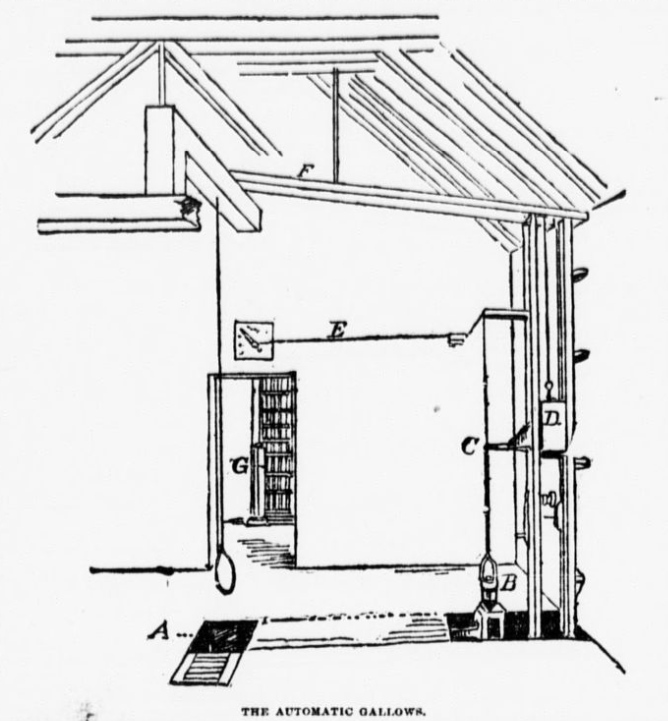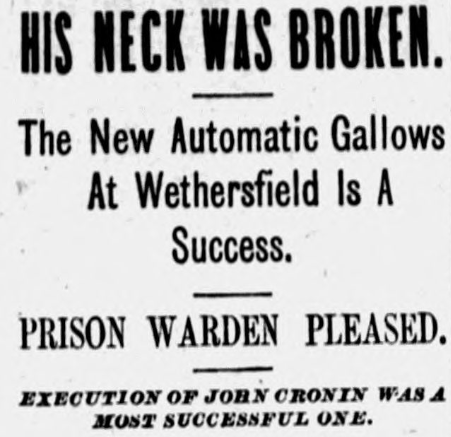
Before 1889, Colorado hangings were public and gruesome. Those condemned to die by hanging sometimes twitched and kicked about on the end of a rope before dying of strangulation.
New laws were passed in Colorado and public hangings were stopped altogether. Instead, prisoners at the State Prison in Canon City, Colorado were given private hangings with the use of what was called a self-hanging machine or an automatic gallows.

A newspaper article published in 1891 described the machine:
“In the upper part of a square frame made of four uprights, a bucket is set, the contents of which, when it is ready for operation, weighs 29 pounds. Directly beneath the bucket, and connected with it by a rubber hose, was a valve in another bucket, and connected to the upper bucket by a lever is a 40 pound iron ball, which connects with an iron rod, which keeps in place at a height of 6 feet.
“The weight of 250 pounds, which, when the water is drawn from the bucket, is allow to descend, jerking the condemned man off his feet about three feet in the air. From this large weight a rope runs through two pulleys over a partition and then down into the execution room, where it hangs directly over a platform three feet square, on which the condemned man stands.”
When it was time to hang the condemned, he was brought into the hanging room. A black cap was placed over his head and then the noose was put into position. The condemned was then allowed to say one last goodbye and then he was told to step onto the platform.

The weight of the condemned caused the water to flow, and then the condemned waited. And waited. Instead of an instant drop at the platform, it took a few minutes before the condemned prisoner was jerked upwards, several feet into the air.
Some referred to this reverse hanging as being “jerked to Jesus,” but it does not appear that the automatic noose killed the condemned faster than the traditional drop.
In 1928, it was reported that Raymond Noakes was hanged at 12:40 am and pronounced dead 13 minutes later. Arthur Osborn was hanged at 1:15 am and pronounced dead 15 minutes later. Witnesses to the hanging were sworn to secrecy as to the events of the hangings and why it took so long for the condemned to reach their deaths.

Of course, the automatic gallows was not unique to Colorado. The Connecticut State Prison also used the upright jerker beginning in 1894. The Connecticut jerker reportedly had a faster jerk time than the Colorado jerker, and it also allowed the Warden to speed up a hanging. This newer automatic gallows was later patented in 1895.
At the Connecticut hanging of John Cronin in 1894, it was reported that:
“Cronin stepped upon the platform and at once the hand on the dial showed that the machinery of the automatic gallows had begun to work. Meanwhile the Keeper fastened the strap about Cronin’s legs and the Deputy Warden adjusted the noose about his neck. This completed the arrangements and only twenty seconds had elapsed. The machine was set for forty seconds before the trap would spring, but there is an arrangement by which the warden can spring the trap at any instant and as the deputy warden completed his arrangements he raised his right hand and immediately, without waiting for the shot to run out of the automatic spring, the warden pressed a lever and Cronin’s body shot into the air. This was at exactly 1:02 am.”
Cronin was pronounced dead seven and one-half minutes later.
The automatic gallows was used in Colorado up until 1933. Shortly after the hanging of Walter Jones, the Warden had the machine demolished in order to make room for the new lethal gas chamber. Connecticut stopped using its automatic jerker shortly after Colorado and began using the electric chair in 1936.

